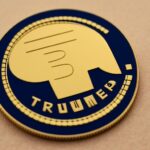Following the latest industry reports, the US Securities and Exchange Commission (SEC) and Nasdaq are moving fast to bring blockchain into equity markets via tokenized securities, turning shares of companies like Apple, Nvidia, and Tesla into digital tokens on-chain.
- What Are Tokenized Securities and Nasdaq’s Proposal
- Regulatory Position: Peirce, SEC, and the Push or Pull
- Institutional Resistance and Infrastructure Challenges
- Roadmap and Risks
- Conclusion
- Summary
- Glossary
- Frequently Asked Questions About Tokenized Securities
- Do tokenized securities replace traditional stocks?
- When can tokenized stocks trade live?
- Will tokenizing shares change shareholder rights?
- Who controls custody of tokenized shares?
Nasdaq just filed rule change proposals to allow tokenized stocks to trade alongside traditional shares under the same execution and rights framework.
Crypto companies and fintech platforms are welcoming the change, but legacy financial institutions are pushing back, citing structural risks and protection of traditional roles. Even so, SEC Commissioner Hester Peirce said tokenized assets are securities and must comply with existing rules.
What Are Tokenized Securities and Nasdaq’s Proposal
Tokenized securities are digital representations of traditional assets such as equities or ETPs; issued as blockchain-based tokens; while retaining the same rights (voting, dividends, liquidity) as their traditional counterparts.
Early last month; Nasdaq filed a proposed rule change (SR-NASDAQ-2025-072) with the SEC to allow listed equities and ETPs to trade in tokenized form alongside their traditional versions. Under the plan; tokenized shares must be fungible with traditional shares, have the same CUSIP, and have the same rights.

Investors will have a choice: to settle a trade via traditional method or blockchain. Execution, routing, surveillance, and reporting will be the same; only settlement will be different.
The Depository Trust Company (DTC) will mint the tokenized version post-trade and deliver it to participants’ blockchain wallets while still supporting T+1 settlement.
Nasdaq expects first live token-settled trades by Q3 2026, pending SEC and DTC readiness.
Also read: How Coinbase Takes Charge! Leads The U.S. Into Tokenized Securities
Regulatory Position: Peirce, SEC, and the Push or Pull
Tokenizing securities sits at the intersection of innovation and regulation. SEC Commissioner Hester Peirce; often considered crypto-friendly, said tokenized securities don’t change the fundamental nature of the asset. She said,
“As powerful as blockchain is, it doesn’t have magic powers to change the nature of the underlying asset. Tokenized securities are still securities.”Peirce has also said the SEC is “happy to talk to people who want to tokenise”.
But others are objecting loudly. The World Federation of Exchanges (WFE) and other incumbent players are pushing back, saying tokenized stocks will erode capital markets infrastructure and create shareholder rights uncertainty. They are urging the SEC and ESMA to tighten up and prevent misuse.
In the Nasdaq proposal itself, tokenized shares are described as “carrying the same rights and protections as underlying securities”. This implies tokenization must operate within existing legal frameworks, not outside of them.
Institutional Resistance and Infrastructure Challenges
Despite the momentum, big players are sounding the alarm. Firms like Citadel Securities, big banks and traditional brokerages see risk to their role in settlement, clearing and custody layers. They argue tokenization will make parts of their infrastructure obsolete or disrupt their business models.
The WFE has warned that some blockchain-based securities “mimic” equities but lack shareholder rights or safeguards. They are urging regulators to regulate “tokenized stocks” as securities not as novel assets.
Roadmap and Risks
From a technical standpoint, DTC needs to build blockchain-ready systems that map tokenized shares to traditional ones. The conversion, accounting, wallet linkage, settlement reconciliation and rollback mechanisms are all hard engineering problems.
Custody is another barrier: who holds the private keys? If it is the institution or clearinghouse, then trust defaults back to centralised systems. If it is the investor, then recovery and compliance is complex. Third party custody providers need to scale.

Liquidity fragmentation risk is present too: if tokenized and traditional markets diverge in depth or routing then price discovery breaks. Ensuring unified order books and equivalence in execution priority is key. Nasdaq is proposing tokenized and traditional shares trade on the same order book.
Nasdaq’s proposal is live and open for comment until October 14, 2025 and then the SEC will review feedback. If approved; token-settled trades could start by Q3 2026; assuming DTC and infrastructure is ready.
Also read: SEC Chair Atkins Narrows the Field: ‘Very Few Tokens Are Securities’
Conclusion
Based on the latest research; letting stocks “trade like crypto” via tokenized securities could change capital markets if done right. Nasdaq’s proposal is a carefully crafted path. Tokenized shares with full rights, unified trading, optional settlement on blockchain and full regulatory compliance.
Commissioner Peirce’s support means the conversation could continue, but tokenization will only work if it respects the legal and structural foundations of traditional markets.
For in-depth analysis and the latest trends in the crypto space, our platform offers expert content regularly.
Summary
Nasdaq has proposed tokenized securities; blockchain versions of stocks and ETFs; to trade alongside traditional shares. Crypto platforms and Peirce are in favour. Wall Street institutions are worried. Infrastructure, DTC readiness, regulatory alignment and clear protections are needed for success.
Glossary
Tokenized securities – Digital tokens on blockchain that represent traditional assets like stocks; with the same rights.
Fungible / fungibility – Interchangeable; identical units ; a token that is identical to its traditional counterpart.
DTC (Depository Trust Company) – The U.S. central securities depository; that handles settlement and record-keeping.
CUSIP – Unique identifier for U.S. financial instruments; ensuring tokenized share maps to traditional counterpart.
Settlement – Process of transferring funds and securities to complete a trade.
Public comment period – Regulatory stage allowing stakeholders to provide feedback before final rule adoption.
Frequently Asked Questions About Tokenized Securities
Do tokenized securities replace traditional stocks?
No. They are the same asset. Tokenized shares must be equivalent and have the same rights.
When can tokenized stocks trade live?
If everything goes well, Q3 2026, pending SEC approval and infrastructure readiness.
Will tokenizing shares change shareholder rights?
Under Nasdaq’s proposal, tokenized shares must have the same rights; voting as traditional shares.
Who controls custody of tokenized shares?
Custody will be centralized to start or use qualified third-party wallet providers or custodians.



















































































































